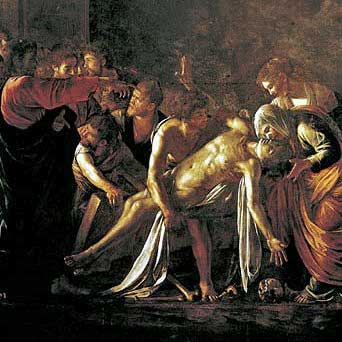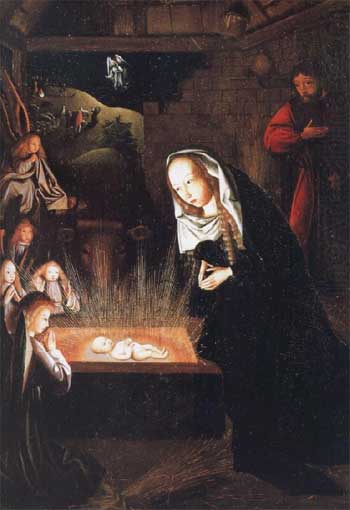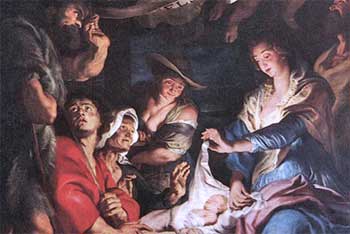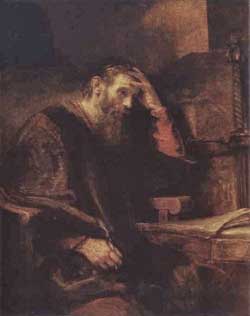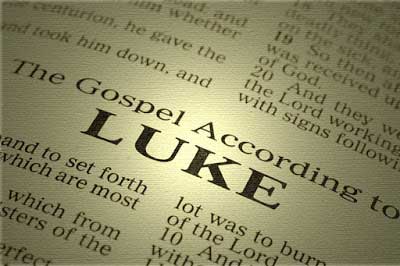
What did the author of Luke-Acts believe about the doctrine known as ‘the atonement?’ “There is at present no satisfactory consensus reached regarding the presentation of the death of Jesus in Luke-Acts. Many models have been proposed, but none seem to deal adequately with all that is going on in Luke-Acts.” See, the diversity of opinion in The Atonement in Lucan Theology in Recent Discussion Some argue that the Lucan Jesus is presented as an innocent martyr, righteous, or lowly man, or that Jesusʼs death was simply a means toward resurrection.
“Many scholars see no atoning significance in the Gospel of Lukeʼs presentation of the death of Jesus and no connection with the forgiveness of sins. There are three passion predictions (9:22; 9:44; 18:31-3), but nothing corresponding to the ‘ransom’ saying in Mark 10:45 and Matthew 20:28, and no ‘cry of dereliction’ from the cross in Luke 23. Even the citations from Isaiah 53 in Luke 22:37 and Acts 8:32-3 are said to demonstrate that Luke is interested ‘not in the atoning death of Jesus but in the fulfillment of scripture in the obedient passion (silence), death (humiliation), and resurrection (taking up from the earth) of the Servant.’” per David Peterson,
Atonement in the Synoptic Gospels, who cites Conzelmann, H., The Theology of St. Luke, (trans. G. Buswell; New York: Harper & Row, 1960), 200-1; and, Sylva, D. D. (ed.), Reimaging the Death of the Lukan Jesus (Frankfurt: Anton Hain, 1990) which records a variety of ways in which the death of Jesus in Luke-Acts has been understood; and, Sylva, Reimaging, 146. In ‘Atonement Theology in Luke-Acts: Some Methodological Reflections,’ in P. J. Williams, A. D. Clarke, P. M. Head, D. Instone-Brewer (ed.), The New Testament in its First Century Setting (Grand Rapids/Cambridge: Eerdmans), 56-71.
Consider the Gospel of Luke where the author mentions that John the Baptist gave his people the knowledge of salvation through the forgiveness of sins because of Godʼs tender mercy (Luke 1:76-78), adding that the Baptist preached a baptism of repentance for the forgiveness of sins (Luke 3:2-4); and the Gospel of Luke ends the same way, by stating that “repentance for the forgiveness of sins will be preached in his [Jesusʼs] name to all nations” (Luke 24:46-48), but nothing about the atoning power of Jesusʼs blood sacrifice. Same with the prayer Jesus taught others to pray per Matthew and Luke, the ‘Our Father,’ that mentions God granting forgiveness to those who forgive others, i.e., without God requiring a blood sacrifice before forgiving sins.)
Scholars point out that the author of Luke-Acts neglected to reproduce crucial verses found in Mark//Matthew that describe Jesusʼ death as a ‘ransom.’ Luke reproduces much of Mark in his gospel, including material from immediately before and immediately after the passage below, but omits this particular passage:
“For even the Son of Man did not come to be served, but to serve, and to give his life as a ransom for many.”
Mark 10:45 / Matt 20:28
Also, Luke 22:19-20 says “And he took bread, gave thanks and broke it, and gave it to them, saying, ‘This is my body given for you; do this in remembrance of me.’” In the same way, after the supper he took the cup, saying, “This cup is the new covenant in my blood, which is poured out for you.” But some manuscripts only have “And he took bread, gave thanks and broke it, and gave it to them, saying, ‘This is my body.’” that is, they lack the bit about a “new covenant in my blood poured out for you.”
Bart Ehrman in “The Orthodox Corruption of Scripture,” makes a compelling case for why the shorter reading is the original. And this is the only passage in Luke that suggests Jesusʼ shed blood had magical atoning power.
Similar to the case found in the Gospel of Luke only a single passage in Acts suggests Jesusʼ shed blood has atoning power:
“Keep watch over yourselves and all the flock of which the Holy Spirit has made you overseers. Be shepherds of the church of God, which he bought with his own blood.” Acts 20:28
That is the only verse in Acts that suggests that Jesusʼ shed blood has atoning power, and much like the verse in Luke, there is a good case to be made that these words were not part of the original.
Without Luke 22:19b-20 and Acts 20:28 there is no concept of blood atonement in Luke-Acts. When Jesus died, according to Luke, it wasnʼt in place of sinners or on their behalf, instead, one need only repent and be baptized in most cases, to accept Godʼs direct mercy.
So if one need only repent and be baptized what is the cross about according to Luke-Acts?
Letʼs have a look at the preaching of Peter and Paul in Acts.
Peter preaches the following in Acts 2, Jesus was a man sent by God. We know he was sent by God because of the miracles. According to Godʼs plan he was killed. God raised him to life. God made him Lord and Messiah. God gave him the Holy Spirit, which he now pours out on his followers. In order to get the Spirit you need to repent and be baptized in Jesusʼs name. Peterʼs message is that forgiveness comes through repentance and baptism and then you get the Holy Spirit.
In Acts 3, Peter preaches that forgiveness comes through repentance and baptism isnʼt mentioned.
In Acts 4, Peterʼs message to the Sanhedrin is that salvation is found in Jesus, but this appears linked to his exalted current status, not to his death.
In Acts 5, Peterʼs words suggest that God exalted Jesus the role of savior after his resurrection, so it was neither the death or resurrection that has saving power, but rather Jesusʼs current exalted status.
In Acts 7 Stephenʼs preaching does not include a ‘gospel’ message, but it is clear that it is the power of the risen Jesus that matters.
In Acts 8, the topic is how you get the Holy Spirit. Again, this seems to be the objective of preaching in Acts.
In Acts 10, Peter preaches to Cornelius, informing him that what God did to Jesus after his ascension is what matters, and believing in the risen Jesus is the way to receive the Holy Spirit.
In Acts 13 Paul preaches the same message, namely that Jesus was a good man, wrongly killed, vindicated by God, raised, and then made Son of God and Savior.
In Acts 17 Paul basically repeats his message in Acts 13.
The preaching of the apostles in Acts repeats the same basic message, Jesus was a good man, wrongly killed. He was vindicated by God and raised from the dead. He became the Son of God and Savior. He can forgive the sins of the repentant and send the Holy Spirit.
Therefore, scholars have noted that a blood atonement is not the major focus of preaching in Acts. It might not be the focus at all in fact if two questionable passages that mention the ‘blood’ are later additions, as textual scholars suspect they are.
The gospel message in Luke-Acts is this: repent, be baptized in the name of Jesus and receive the Holy Spirit.
To add to the above case, note that Luke 19:19ff (NASB), talks about ‘salvation’ coming to Zaccheus after he repents and returns ill gotten gains. This understanding of salvation precedes Jesusʼ death on the cross, and as in every other case mentioned differs from the traditional Christian view that “without shedding of blood there can be no forgiveness of sins.” It also differs from the story of the rich young man in which Jesus told him to give away all of his possessions that he might have treasure in heaven and how difficult it was for a rich man to enter heaven, since Zaccheus only gives away half of what he owns, not all, and still, ‘salvation’ is his. Hereʼs the story in Luke 19:
He [Jesus] entered Jericho and was passing through. 2 And there was a man called by the name of Zaccheus; he was a chief tax collector and he was rich. 3 Zaccheus was trying to see who Jesus was, and was unable because of the crowd, for he was small in stature. [The Greek is ambiguous as to whether or not Zaccheus or Jesus was ‘small in stature,’ though the former is probably meant, though if the latter is meant, it would be the only time in the New Testament where some description of the physical Jesus is presented. Though like I said, it is probably just talking about Zaccheus.] 4 So he ran on ahead and climbed up into a sycamore tree in order to see Him, for He was about to pass through that way. 5 When Jesus came to the place, He looked up and said to him, “Zaccheus, hurry and come down, for today I must stay at your house.” 6 And he hurried and came down and received Him gladly. 7 When they saw it, they all began to grumble, saying, “He has gone to be the guest of a man who is a sinner.” 8 Zaccheus stopped and said to the Lord, “Behold, Lord, half of my possessions I will give to the poor, and if I have defrauded anyone of anything, I will give back four times as much.” 9 And Jesus said to him, “Today salvation has come to this house, because he, too, is a son of Abraham. 10 For the Son of Man has come to seek and to save that which was lost.”
Nor does the passage demonstrate that everyone is “lost,” nor do these other Gospel passages:
“And when Jesus heard it, he said to them, “Those who are well have no need of a physician, but those who are sick; I came not to call the righteous, but sinners.“ Mark 2:17
“But when he heard it, he said, ‘Those who are well have no need of a physician, but those who are sick. Go and learn what this means, “I desire mercy, and not sacrifice.’” For I came not to call the righteous, but sinners.” Matthew 9.12-13
“And Jesus answered them, ‘Those who are well have no need of a physician, but those who are sick; I have not come to call the righteous, but sinners to repentance.’” Luke 5:31-32
In fact Jesus in the Gospels of Matthew and Luke does not say everyoneʼs heart is evil and wicked above all things, but rather states:
“A good man brings good things out of the good stored up in him, and an evil man brings evil things out of the evil stored up in him.” Matthew 12:35
“A good man brings good things out of the good stored up in his heart, and an evil man brings evil things out of the evil stored up in his heart. For the mouth speaks what the heart is full of.” Luke 6:45
Jesus also says to “love God with all your heart” which seems impossible if the heart can will only evil choices and is desperately wicked in everyone at all times.
Moreover, the Bible is a big book and you can find passages that put forth the notion that God does not require blood atonement sacrifices because sometimes grain sacrifices are fine, but even more to the point are passages where God directly forgives people who repent. Such passages state outright that repentance and doing good takes the utmost precedence above all types of sacrifices, so at best atonement sacrifices are secondary in Godʼs eyes:
“For I desire mercy, not sacrifice, and acknowledgment of God rather than burnt offerings.” Hosea 6:6
“He has shown you, O mortal, what is good. And what does the Lord require of you? To act justly and to love mercy and to walk humbly with your God.” Micah 6:8
“Hear the word of the Lord, you rulers of Sodom; listen to the instruction of our God, you people of Gomorrah! “The multitude of your sacrifices—what are they to me?” says the Lord. ‘I have more than enough of burnt offerings, of rams and the fat of fattened animals; I have no pleasure in the blood of bulls and lambs and goats. When you come to appear before me, who has asked this of you, this trampling of my courts? Stop bringing meaningless offerings! Your incense is detestable to me. New Moons, Sabbaths and convocations—I cannot bear your worthless assemblies. Your New Moon feasts and your appointed festivals I hate with all my being. They have become a burden to me; I am weary of bearing them. When you spread out your hands in prayer, I hide my eyes from you; even when you offer many prayers, I am not listening. Your hands are full of blood!’” Isaiah 1:10-15
“Hear, you earth: I am bringing disaster on this people, the fruit of their schemes, because they have not listened to my words and have rejected my law. What do I care about incense from Sheba or sweet calamus from a distant land? Your burnt offerings are not acceptable; your sacrifices do not please me.” Jeremiah 6:19-21
Or, to quote Jesus himself…
“In everything, therefore, treat people the same way you want them to treat you, for this is the Law and the Prophets.”
Matthew 7:12
Thatʼs it. Sounds pretty straightforward, not like the the merry-go-round of questions Christian theologians continue to debate, involving questions like, “Do I have enough faith, love, devotion, correct beliefs, etc.” How much and how fervently and exactly what must I believe in order to be saved? How many doubts and questions can I continue to harbor and remain “saved?” etc. Also see Part 2 of this series.
